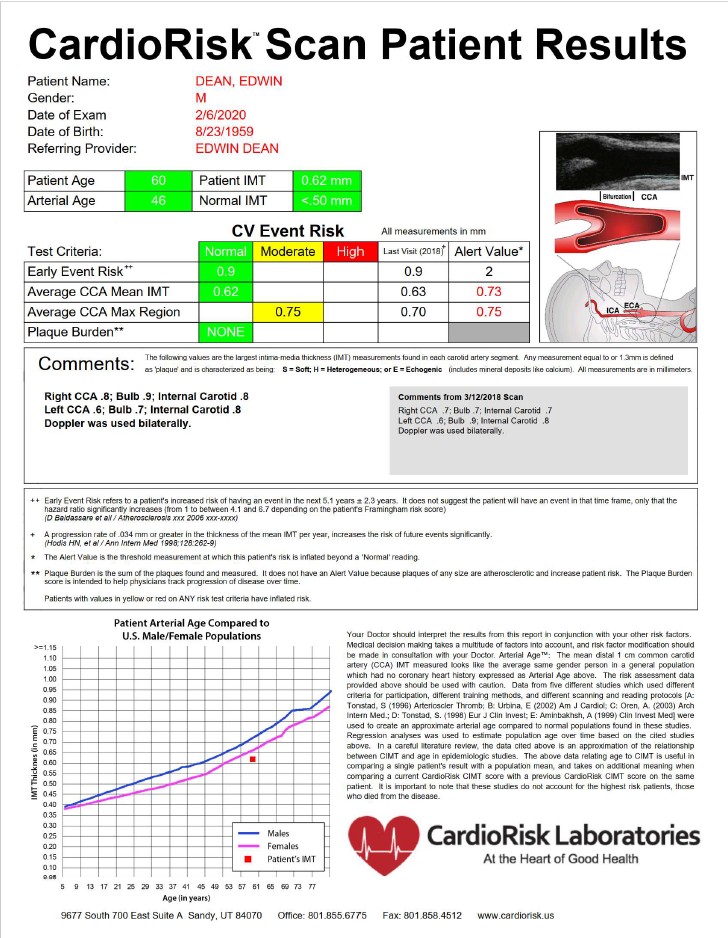
CIMT Health Risk Assessment at NAWI Naples
Carotid Intima-Media Thickness (CIMT) from CardioRisk is a cutting-edge ultrasound test that measures the thickness of the inner two layers of your carotid artery wall. It is a direct is a measure of your overall all arterial health. This is Dr. Dean’s Number 1 Favorite Test from the entire scope of medical testing because it has prevented more illnesses and motivated more healthy habits than any other test. The goal is to catch problems early, so you can stay healthy and avoid serious health issues later on. “We want our clients to get to 80 years old with 60 year-old arteries and not find out that they have 80 year-old arteries when they are 60.”, says Dr Dean. He goes on, “This may be the best $350 you have ever spent.”
What does the CIMT Test Tell Me?
The CIMT test provides you with some very important information about your arterial age and your overall health.
First, the CIMT quantifies arterial (vascular) age, how your arteries compared to what’s expected for your age, and identifies early changes before symptoms arise. This also allows monitoring of the effects of medical and lifestyle changes on vascular health
Second, the CIMT provides a health risk insight. This test identifies early hardening or narrowing of the arteries (e.g., atherosclerosis) before serious health events. This information can help guide lifestyle changes and medical therapy to lower the risk of heart attack, strokes and poor health from an unhealthy vascular system
If your CIMT arterial age is higher than your actual age, it can mean your arteries are starting to show signs of hardening or narrowing. This doesn’t always mean you have heart disease now, but it does mean you may have a higher risk in the future. Knowing this early gives you and your doctor time to take action—through lifestyle changes, medication, or other treatments—to help protect your heart and brain.
When is the CIMT Offered at NAWI?
NAWI hosts CIMT clinics with CardioRisk twice per year, typically in the Fall and Spring. Appointments are limited and fill quickly. Schedule a CIMT at NAWI by clicking here
Listen to Dr. Ford Brewer Talk About CIMT in the Video Below
Do You Want More Information About CIMT Testing?
Who Should Get Tested?
This test is recommended for anyone aged 40or older. Additionally, younger adults with cardiovascular risk factors, such as high blood pressure, high cholesterol, diabetes, smoking, or a family history of heart diseases, should strongly consider testing.
How often should I get tested?
Dr Dean recommends repeating the CIMT at least every 2 years to monitor and assess whether your health strategies -nutrition, exercise, and medication- are working to improve your health. Because the test is a simple, quick and painless ultrasound of the neck—no needles, no radiation- you can get tested as often as you like.
How the Test Works
A trained sonographer places a small ultrasound probe on your neck to image your carotid arteries. CardioRisk’s sophisticated protocol and ultra-high-resolution ultrasound captures more than 600 precise measurements in under 10 minutes. These are analyzed with computer technology to produce accurate and reproducible results within 0.02 millimeters- 2 one hundredths of a millimeter! When measuring the thickness between layers of the artery, which ideally is less than 0.75 millimeters, you need that level of resolution to provide optimal data that you can rely on and act on!
Is the CIMT the same test offered at Health Fairs, Mobile Units in Church Parking Lots and Hospitals?
Absolutely not! All tests have their merits and shortcomings. Traditional ultrasounds are looking for major blockages. Frequently, significant abnormalities go unnoticed in standard reports, but CardioRisk CIMT can identify them early, allowing patients time to take corrective action. While they are both ultrasounds, the difference in technologies is like comparing the Wright Brother’s plane and Space X, both allow you to fly but one will potentially get you to the moon and the other may auger you into the ground.
Aren’t cholesterol levels a good indicator of cardiovascular health?
Unfortunately, they are not! One important and shocking statistic is that 50% of those arriving in the Emergency Department with a heart attack have a “healthy cholesterol”. For over 50 years, the medical establishment has used cholesterol (Total, LDL, HDL, Triglycerides, and other variations) as surrogate markers for vascular health, when the data says that they can be poor predictors of health. Using these indicators alone can mislead one’s presumptions of risk. Don’t wait until you are in the ambulance or worse to consider CIMT testing.
This Is An Actual CIMT Test Result

